Exploring Hue Royal Court Music, the ancient cultural heritage of Hue
2Hue, located in the central region of Vietnam, appeals to tourists with its historical and cultural values and charming natural landscapes. Besides visiting the relics complex of the Nguyen Dynasty and the sacred pagodas, enjoying the Hue royal court music is also an experience that you should not miss. This is a proud intangible cultural heritage and a unique form of Vietnamese music and art. Let’s explore this amazing type of music and art with Handspan Travel Indochina!
Through this blog post, you will find these pieces of information below.
General information about the Hue Royal Court Music
Unlike other genres of Vietnamese music, Royal Court Music is the only type of music that has national character. In ancient times of Vietnam, this type of music was popular in Giao and Mieu ceremonies and during royal ceremonies. Royal court music involves all genres of music, dance, and drama, used in sacrificial and court ceremonies as well as national holidays organized by the court.
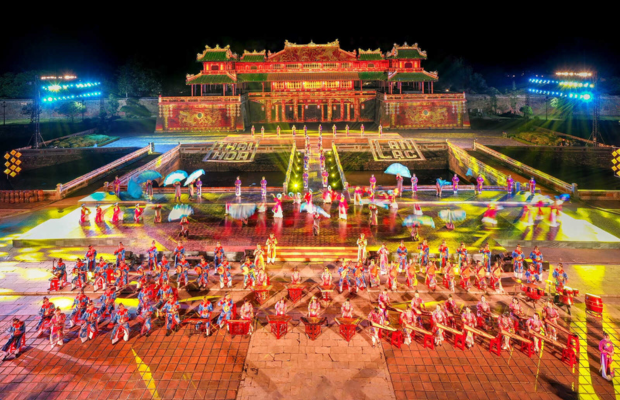
Hue Royal Court Music
Dated back from the Ly Dynasty (1010 - 1225); however, it was until the Nguyen Dynasty (1802 - 1945) that the Hue Royal Court Music thrived again and became more organized. At that time, the royal court was honored as the national music. Therefore, artists only performed it in the Hue Citadel on important and meaningful holidays such as the Nam Giao and Xa Tac ceremonies, coronation ceremonies, king's longevity celebrations, and the reception of envoys, etc.
In 2003, UNESCO recognized Hue Royal Court Music as an intangible cultural heritage. Currently, Hue Royal Court Music with forms such as orchestra, songs, pieces, and dances is performed on many occasions. They are Hue Festival, Buddhist festivals, folk festivals, chamber music, etc. It is also performed in diplomatic ceremonies, performing for tourists and locals during major festivals and traditional New Year, etc. Therefore, Hue Royal Court Music’s artistic value is still preserved, preserved, and continues to be promoted.
The artistic value of the Hue Royal Court Music
Hue Royal Court Music has many values that the local authority and local people still preserve today. These values come from the musical structure, musical instrument organization, and the combination of Hue Royal Court Music and dance. Let’s explore this unique national type of performing art with us!
Hue Royal Court Music’s musical structure
In the past, most of the musical chapters of Nha Nhac were compiled by the Ministry of Rites. Depending on the different nature of the ceremonies, the musical chapters will also be different. For example, the Giao ceremony will have 10 musical chapters to represent success. Meanwhile, the Xa Tac ceremony will have 7 musical chapters implying the wish for a good harvest. The Mieu ceremony will have 9 musical chapters, wishing for harmony. The Lich Dai De Vuong ceremony will have 6 musical chapters expressing wisdom. On the occasion of the Dai Trieu ceremony, artists will perform 5 songs to express the wish for peace. The Van Tho ceremony will use 7 songs that mean longevity, and the Dai Yen ceremony will use 5 songs that express blessings.
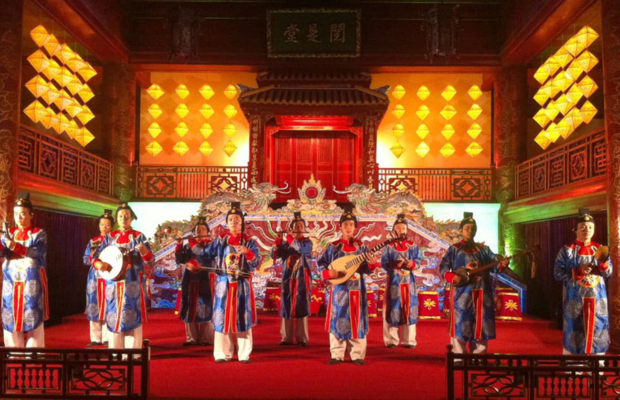
Performing Hue Royal Court Music
Musical instrument organization of the Hue Royal Court Music
Hue Royal Court Music has Grand Music and Small Music forms. The Grand Music form is extremely important in the Hue Royal Court Music. It is performed in the most important forms in ceremonies, with high volume. The grand orchestra is suitable for ceremonies such as the Nam Giao ceremony, Mieu ceremony, etc. Compared to the past instruments, the current orchestra is smaller.
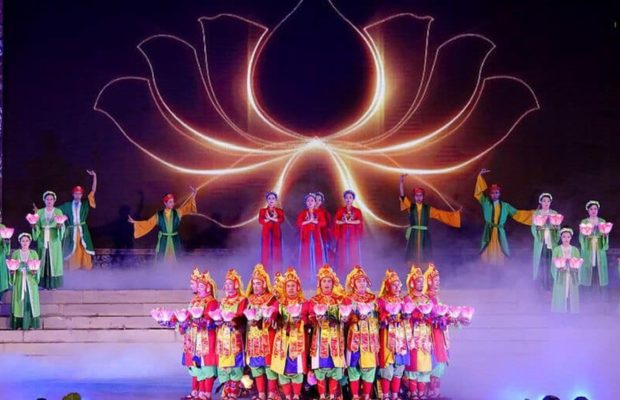
Performing Hue Royal Court Music
The structure of the Grand Music form includes percussion instruments (big drum, war drum, bong drum, cymbal, buffalo horn, rice drum); wind instruments (trumpet), and string instruments (erhu). Compared to the Grand Orchestra, the music of the Small Orchestra is relatively stable. The music has an elegant and cheerful color and is often used in royal banquets, grand celebrations, and Lunar New Year. The Small Music’s musical instruments include percussion instruments (drum, zither, clapper), wind instruments (flute), and string instruments (moon lute, pipa, three-stringed lute, two-stringed fiddle).
Royal court music combined with Hue royal court dance
Besides the royal court music, the court dance in the Nguyen Dynasty was also impressive, diverse, and rich. Nguyen Dynasty court dance absorbed the dances from the royal court and folk dances of previous dynasties, improving and creating new dances with the characteristics of the Nguyen Dynasty performing arts. The dance was mainly group dance, thematic ideas were often expressed in moving formations and ended with a standing formation. Some prominent court dances were the Bat Dat dance, the Luc Cung Hoa Dang dance, the Lion Dance, etc.
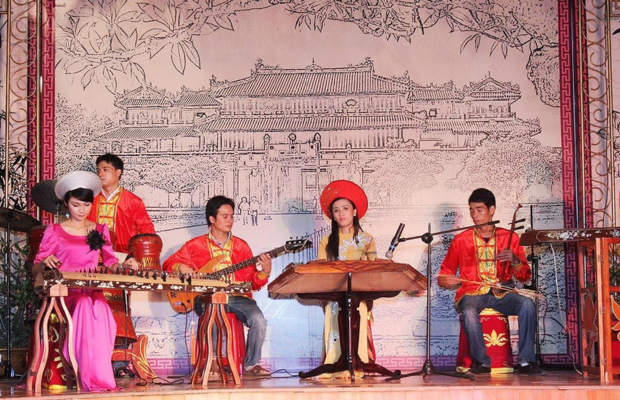
Hue Royal Court Music artists
Exploring the instruments used in the Hue Royal Court Music performance
As mentioned, the Hue Royal Court Music has the Grand and Small Music forms. These two forms all have three main types of instruments, including percussion instruments, string instruments, and wind instruments. Let’s explore how artists combine these instruments in the Hue Royal Court Music with us!
Percussion instruments
Percussion instruments in the Hue Royal Court Music are essential in keeping the beat and creating a solemn and sacred atmosphere for royal ceremonies. They can lead other instruments and reflect the authority of the court. Below are typical percussion instruments in Nha Nhac.
- Drums (Trong Cai)
Large drums are suitable for major royal ceremonies, such as the Nam Giao ceremony, coronation ceremonies, or royal banquets. The sound of the big drum is loud and powerful, symbolizing the power and authority of the king. Whereas, the smaller drums can emphasize rhythm in court music performances, often accompanied by other instruments to create harmony.
- Gongs (Chieng)
Gongs are instruments made from bronze, creating a resounding sound when struck. In royal music, gongs create rhythm and can coordinate with drums. Gongs come in many different sizes, and each type of gong will be suitable for different occasions and spaces. In large ceremonies, artists combine gongs with drums to create a majestic sound, emphasizing the sacredness of the ceremony.
- Clappers (Phach)
Phach is a small instrument made from wood. Artists strike two pieces of clappers together to produce a sharp, fast sound. The clapper keeps the beat of music that has a light, steady rhythm.
- Command drums
The command drum is a special type of drum that artists use to give commands during ceremonies or performances. When the command drum is played, the musicians and other instruments will follow the beat of the drum to start or end the music. The command drum represents power and plays a very important role in directing the tempo and coordination of the orchestra.
String instruments
String instruments create the melody and emotion of the Hue royal court music. The high and low, gentle or deep sounds of stringed instruments help express elegance and nobility, suitable for the context of solemn royal court ceremonies. Below are typical string instruments in the Hue Royal Court Music.
- Moon lute (Dan Nguyet)
Moon lute is a two-stringed lute with a round body and two silk strings. The moon lute often produces a gentle, soft, and ethereal sound, evoking a sense of nostalgia and serenity. The sound of the moon lute is very suitable for songs of a calm, profound nature and has a slow, solemn rhythm.
- Pipa (Dan Ty Ba)
The pipa is a lute looking like a pear with four strings. It is impressive with its elegant, flowing melodies. This is one of the most iconic string instruments in court music.
- Erhu (Dan Nhi)
The Erhu is a two-stringed instrument with a high-pitched, clear sound. It is a simple instrument with a long body and a small wooden or leather resonator, and a fretless neck. The player uses a bow to pull the strings to produce sound.
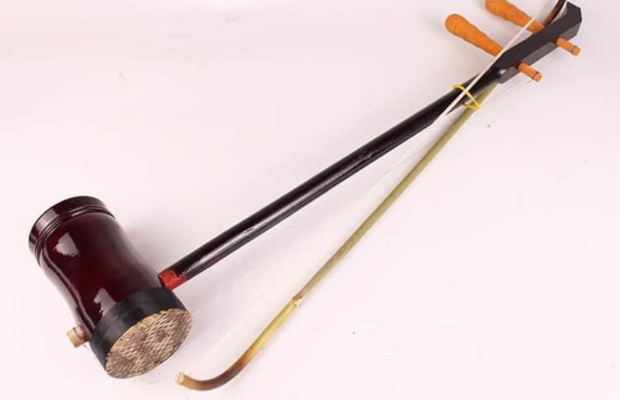
Erhu
- Dan Tranh
Dan Tranh is a typical instrument in the Hue Royal Court Music performance. It is a stringed instrument with many strings (usually 16 to 21 strings) stretched over a long resonator. Artists pluck each string by hand or with a pick to produce a clear, flexible sound. The sound of the Dan Tranh can express many nuances, from gentle, and deep to strong, and vibrant.
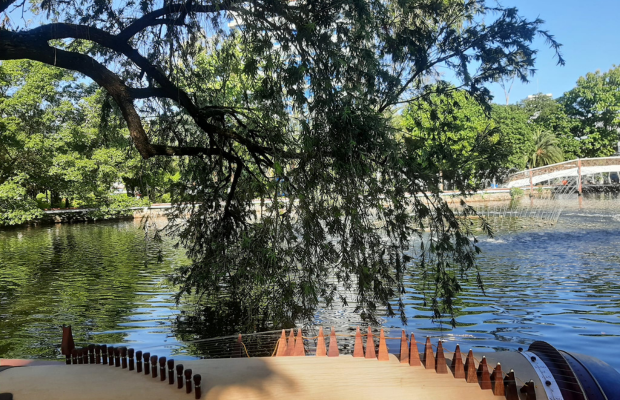
Dan Tranh
Stringed instruments in Nha Nhac are not only tools to create sound but also symbols of nobility, elegance, and depth in Hue royal court music.
Wind instruments
Wind instruments often play the leading melodic roles and are responsible for setting the tone of the Hue Royal Court Music performance. Here are some popular wind instruments.
- Tieu (Flute): A vertical bamboo flute, often associated with peaceful, introspective tunes.
- Dich (Horizontal flute): Another type of bamboo flute that can produce quick, lively melodies.
- Ken bau (Oboe): A traditional wind instrument that produces a loud, reedy sound, often leading processional music.
- Trumpet (Ken Tay): A wind instrument with a resonant sound, often used in parades, receptions, or important events of the royal palace.
Wind instruments in Nha Nhac not only convey melodies but also bring soul to court music, contributing to creating musical pieces of high artistic value and reflecting the unique cultural features of the Nguyen Dynasty.
Where to watch the Hue Royal Court Music performances?
You can choose to stay on a boat and watch the Hue Royal Court Music performances on the Huong River. Otherwise, you can visit Duyet Thi Duong to watch this unique form of art. Let’s see some detailed information about the venue, time, and ticket price.
Watching the Hue Royal Court Music on the Huong River
Huong River is a popular spot to see the royal court music performances. You will buy tickets to board a dragon boat, cruise along the poetic Huong River, and enjoy Nha Nhac and other musical genres performed by singers. The ticket to watch the performance while boating and admiring the Huong River at night is VND 100,000 per person. Each show lasts 1 hour from 07.00 p.m. to 08.00 p.m. or 08.00 p.m. to 09.00 p.m. daily. You can buy tickets in advance or directly at the Kham boat dock right at Trang Tien Bridge.

Performing Hue Royal Court Music on Huong River
Duyet Thi Duong
Duyet Thi Duong, located on the campus of Hue Imperial City, is the first theater to open for performing Nha Nhac, built under the Nguyen Dynasty, nearly 200 years ago. This is also one of the oldest performing spaces in Vietnam with many art genres such as Tuong, dance, and Nha Nhac for the royal palace. Coming to Duyet Thi Duong, you will feel excited with the grand, solemn space and sacred atmosphere. It costs you VND 200,000 per person to see the Hue Royal Court Music at Duyet Thi Duong. Each performance lasts 30 minutes. You can choose to see the performance at 10.00 a.m. or 03.00 p.m.
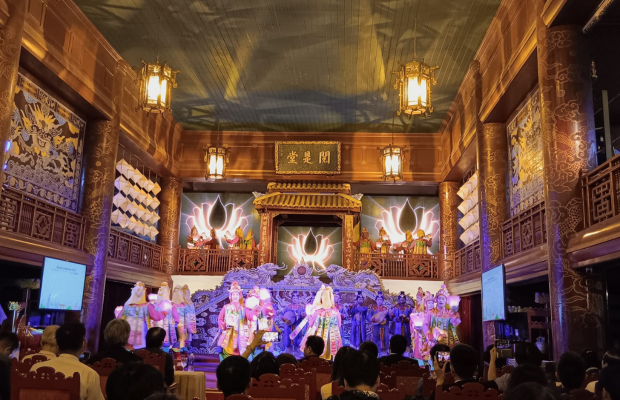
Performing Hue Royal Court Music at Duyet Thi Duong
In conclusion, Hue Royal Court Music is a priceless intangible asset, the pride of the Vietnamese people and the people of Hue. If you travel to Hue, don’t miss out on the opportunity to enjoy the Hue Royal Court Music performance. For further information, book a Hue tour package, or tailor your tour, please do not hesitate to contact our team.
__logo.png)
__hanoi-water-puppets.jpg)
__angkor-wat-blue-reflections.jpg)
__vientiane-buddha-park-monks.jpg)
__bagan-dhammayazika-dusk.jpg)
